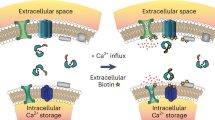Abstract
In the hydrozoan coelenterate Obelia geniculata, epithelial cell action potentials trigger light emission from photocyte effector cells1,2 containing obelin, an endogenous calcium-activated photoprotein3–5. As this luminescence is blocked by the removal of extracellular calcium it seemed likely that calcium entry via voltage-gated channels in the photocyte membrane would account for the light emission. However, no inward calcium current was detected in whole cell recordings, from dissociated photocytes and depolarization of isolated photocytes produced no luminescence. In contrast, a voltage-dependent calcium current was recorded from non-luminescent support cells, and activation of this current triggered luminescence in an adjacent photocyte. Surprisingly, light emission was abolished when the gap junctions between the photocyte and support cell were blocked. We conclude that calcium entry into support cells leads to light emission from neighbouring photocytes via chemical signalling through intercellular gap junctions.
This is a preview of subscription content, access via your institution
Access options
Subscribe to this journal
Receive 51 print issues and online access
$199.00 per year
only $3.90 per issue
Buy this article
- Purchase on Springer Link
- Instant access to full article PDF
Prices may be subject to local taxes which are calculated during checkout
Similar content being viewed by others
References
Morin, J. G. & Cooke, I. J. exp. Biol. 54, 707–721 (1971).
Morin, J. G. in Coelenterate Biology: Reviews and New Perspectives, 397–438 (Academic, New York, 1974).
Campbell, A. K., Biochem. J. 143, 414–418 (1974).
Stephenson, D. G. & Sutherland, P. J. Biochim. biophys. Acta 678, 65–75 (1981).
Morin, J. G. & Hastings, J. W. J. cell Physiol. 77, 313–318 (1971).
Morin, J. G. & Reynolds, G. Biol. Bull. 147, 397–410 (1974).
Johnson, F. et al. J. cell. comp. Physiol. 60, 85–104 (1963).
Hagiwara, S. & Byerly, L. A. Rev. Neurosci. 4, 69–125 (1981).
Rogawski, M. A. Trends Neurosci. 8, 214–219 (1985).
Johnston, M. F., Simon, S. A. & Ramon, F. Nature 286, 498–500 (1980).
Spray, D. C., White, R. L., Campos de Carvalho, A., Harris, A. L. & Bennett, M. V. L. Biophys. J. 45, 219–230 (1984).
Spray, D. C., Stern, J. H., Harris, A. L. & Bennett, M. V. L. Proc. natn. Acad. Sci. U.S.A. 79, 441–445 (1982).
Lawrence, T. S., Beers, W. H. & Gilula, N. B. Nature 272, 501–506 (1978).
Rasmussen, H. & Goodman, D. B. P. Physiol. Rev. 57, 421–509 (1977).
Author information
Authors and Affiliations
Rights and permissions
About this article
Cite this article
Dunlap, K., Takeda, K. & Brehm, P. Activation of a calcium-dependent photoprotein by chemical signalling through gap junctions. Nature 325, 60–62 (1987). https://doi.org/10.1038/325060a0
Received:
Accepted:
Issue Date:
DOI: https://doi.org/10.1038/325060a0
This article is cited by
-
Protein-protein complexation in bioluminescence
Protein & Cell (2011)
-
Ca2+ lightning conveys cell–cell contact information inside the cells
EMBO reports (2006)
-
Distribution of ?2-like adrenergic receptors in the cnidarian Renilla koellikeri as revealed by autoradiography and in situ hybridization
Cell and Tissue Research (1994)
-
Development changes in regulation of embryonic chick heart gap junctions
The Journal of Membrane Biology (1991)
-
Propagation of bioluminescence in Euphysa japonica hydromedusae, (Tubulariidae)
Hydrobiologia (1991)
Comments
By submitting a comment you agree to abide by our Terms and Community Guidelines. If you find something abusive or that does not comply with our terms or guidelines please flag it as inappropriate.



